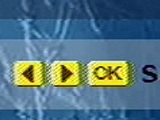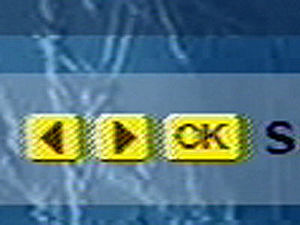
Dot crawl
Encyclopedia

Composite video
Composite video is the format of an analog television signal before it is combined with a sound signal and modulated onto an RF carrier. In contrast to component video it contains all required video information, including colors in a single line-level signal...
, as in terrestrial broadcast television
Terrestrial television
Terrestrial television is a mode of television broadcasting which does not involve satellite transmission or cables — typically using radio waves through transmitting and receiving antennas or television antenna aerials...
. It consists of animated checkerboard
Checkerboard
A checkerboard or chequerboard is a board of chequered pattern on which English draughts is played. It is an 8×8 board and the 64 squares are of alternating dark and light color, often red and black....
patterns which appear along vertical color
Color
Color or colour is the visual perceptual property corresponding in humans to the categories called red, green, blue and others. Color derives from the spectrum of light interacting in the eye with the spectral sensitivities of the light receptors...
transitions. It results from intermodulation
Intermodulation
Intermodulation or intermodulation distortion is the amplitude modulation of signals containing two or more different frequencies in a system with nonlinearities...
or crosstalk between chrominance
Chrominance
Chrominance is the signal used in video systems to convey the color information of the picture, separately from the accompanying luma signal . Chrominance is usually represented as two color-difference components: U = B' − Y' and V = R' − Y'...
and luminance components of the signal, which are imperfectly multiplex
Multiplexing
The multiplexed signal is transmitted over a communication channel, which may be a physical transmission medium. The multiplexing divides the capacity of the low-level communication channel into several higher-level logical channels, one for each message signal or data stream to be transferred...
ed in the frequency domain
Frequency domain
In electronics, control systems engineering, and statistics, frequency domain is a term used to describe the domain for analysis of mathematical functions or signals with respect to frequency, rather than time....
.
This takes two forms: chroma interference in luma (chroma being interpreted as luma), and luma interference in chroma.
Dot crawl is most visible when the chrominance is transmitted with a high bandwidth, so that its spectrum
Spectrum
A spectrum is a condition that is not limited to a specific set of values but can vary infinitely within a continuum. The word saw its first scientific use within the field of optics to describe the rainbow of colors in visible light when separated using a prism; it has since been applied by...
reaches well into the band of frequencies used by the luminance signal in the composite video signal. This causes high-frequency chrominance detail at color transitions to be interpreted as luminance detail.
Some (mostly older) video game consoles and computers use nonstandard color burst phases and may produce dot crawl quite different from that seen in broadcast NTSC or PAL.
The opposite problem, luminance interference in chroma, is the appearance of a colored noise in image areas with high levels of detail. This results from high-frequency luminance detail crossing into the frequencies used by the chrominance channel and producing false coloration, known as color bleed. Bleed can also make narrowly-spaced text difficult to read. Some computers, such as the Apple II
Apple II
The Apple II is an 8-bit home computer, one of the first highly successful mass-produced microcomputer products, designed primarily by Steve Wozniak, manufactured by Apple Computer and introduced in 1977...
, utilized this to generate color.
Dot crawl has long been recognized as a problem by professionals since the creation of composite video, but was first widely noticed by the general public with the advent of Laserdisc
Laserdisc
LaserDisc was a home video format and the first commercial optical disc storage medium. Initially licensed, sold, and marketed as MCA DiscoVision in North America in 1978, the technology was previously referred to interally as Optical Videodisc System, Reflective Optical Videodisc, Laser Optical...
s.
Dot crawl can be greatly reduced by using a good comb filter
Comb filter
In signal processing, a comb filter adds a delayed version of a signal to itself, causing constructive and destructive interference. The frequency response of a comb filter consists of a series of regularly spaced spikes, giving the appearance of a comb....
in the receiver to separate the encoded chrominance signal from the luminance signal. When the NTSC standard was adopted in the 1950s, TV engineers realized that it should theoretically be possible to design a filter to properly separate the luminance and chroma signals. However, the vacuum tube
Vacuum tube
In electronics, a vacuum tube, electron tube , or thermionic valve , reduced to simply "tube" or "valve" in everyday parlance, is a device that relies on the flow of electric current through a vacuum...
-based electronics of the time did not permit any cost-effective method of implementing a comb filter. Thus, the early color TVs used only notch filters, which cut the luminance off at 3.5 MHz. This effectively reduced the luminance bandwidth (normally 4 MHz) to that of the chroma, causing considerable color bleed. By the 1970s, TVs had begun using solid-state electronics and the first comb filters appeared. However, they were expensive and only high-end models used them, while most color sets continued to use notch filters.
By the 1990s, a further development took place with the event of three-line digital comb filters. This type of filter uses a computer to analyze the NTSC signal three scan lines at a time and determine the best place to put the chroma and luminance. During this period, digital filters became standard in high-end TVs while the older analog filter began appearing in cheaper models (although notch filters were still widely used).
However, no comb filter can totally eliminate NTSC artifacts and the only complete solutions to dot crawl are not to use NTSC or PAL composite video, maintaining the signals separately by using S-Video
S-Video
Separate Video, more commonly known as S-Video and Y/C, is often referred to by JVC as both an S-VHS connector and as Super Video. It is an analog video transmission scheme, in which video information is encoded on two channels: luma and chroma...
or component video
Component video
Component video is a video signal that has been split into two or more component channels. In popular use, it refers to a type of component analog video information that is transmitted or stored as three separate signals...
connections instead, or encoding the chrominance signal differently as in SECAM
SECAM
SECAM, also written SÉCAM , is an analog color television system first used in France....
or any modern digital video
Digital video
Digital video is a type of digital recording system that works by using a digital rather than an analog video signal.The terms camera, video camera, and camcorder are used interchangeably in this article.- History :...
standard as long as the source video has never been processed using any video system vulnerable to dot crawl.
Monochrome film recordings of colour television programs may exhibit dot crawl, and starting in 2008 it has been used to recover the original colour information in a process called colour recovery
Colour recovery
Colour recovery is a process which can restore lost colour, specifically to television programmes which were originally transmitted in colour, but for which only black & white copies remain archived...
.

